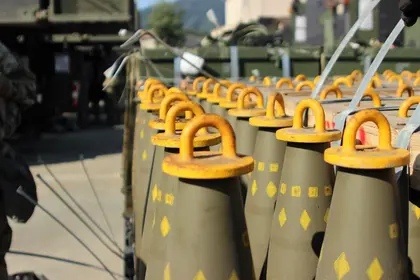In September 2022, Daniel Rice a US advisor to General Valery Zaluzhny, the commander in chief of the Ukraine Armed Forces (AFU), wrote an article advising Ukraine to request the supply of DPICM from US stockpiles. For several months the Ukrainian government echoed the requests to be supplied with cluster munitions.
At the Munich Security Conference in February 2023, Ukraine’s deputy prime minister, Olexandr Kubrakov, and foreign minister, Dmytro Kuleba, appealed for Ukraine to be supplied with cluster munitions.
- View the most up-to-date Ukraine news articles published today.
- Russian Losses in Ukraine
JOIN US ON TELEGRAM
Follow our coverage of the war on the @Kyivpost_official.
Finally, on July 7 the Department of Defense (DoD) announced another round of critical security and defense equipment to Ukraine; the Administration's forty-second drawdown of equipment for Kyiv. The DoD statement said the package would provide additional air defense munitions, armored vehicles, anti-armor weapons, artillery systems and ammunition.
The statement said that, after extensive consultations with Congress, Allies and partners, this would include the “highly effective and reliable” dual-purpose improved conventional munitions (DPICM). According to media reports, Ukraine will receive a significant number of these warheads, potentially numbered in the hundreds of thousands. The nature of the munition, especially in the quantities suggested, would have a noticeable potentially game-changing impact on the battlefield.
Why did Ukraine want DPICM?

Zelensky’s Top General Syrsky Admits Ukraine’s Army Faces Challenges – But Says Fixes Are Coming
Russian occupying forces have spent months developing fortifications consisting of extensive in-depth minefields and trench lines. Ukraine’s counteroffensive has so far found progress difficult mainly because of a shortage of artillery rounds fitted with unitary high explosive warheads as trenches are built to withstand this type of indirect fire.
Artillery is essential if Russian indirect and direct fire is to be suppressed and to allow Ukrainian forces to assault Russian trenches and break the defense line. Cluster munition artillery shells will give Ukrainian artillery the ability to cover more ground and do so faster using a smaller number of total shells.
Additionally, they can be employed to deliver suppressive fire against weapons, equipment and personnel in the open. DPICM could also be used to aid Ukrainian sappers to clear the huge minefields that defend the Russian lines or even to destroy the mines if fired directly onto the minefields prior to an attack.
So, what is the DPICM, what is special about them and how do they work?
DPICM describes a general type of US munition which includes a wide range of artillery shells, rockets, and missiles loaded with submunitions. It includes shells for 105mm, 155mm, and 203mm howitzers, as well as 227mm artillery rockets that can be fired from the M270 Multiple Launch Rocket System (MLRS) and the M142 High Mobility Artillery Rocket System (HIMARS) launchers.
Currently, the US has only agreed to provide the Ukrainian Armed Forces (AFU) with a single type of DPICM, the 155mm artillery shells.
Western nations have transferred several different 155mm howitzers to Ukraine both towed guns, such as the US M777 and the UK-designed FH-70, and self-propelled guns, such as the US-designed M109 and the German PzH 2000. The DPICM rounds that Washington is transferring to Kyiv are fired from any of the standard NATO 155mm howitzers provided by Ukraine’s Western partners over a range of around 20-25 kilometers.
Each munition contains 88 M77 submunitions, each of which has a lethal range of about 10 square meters. This means one shell can impact an area of up to 18,000 square meters, depending on the height set for the release of the submunitions. This compares with the blast and fragmentation area from a standard high explosive 155mm artillery round of around 7,000 square meters.

| Components of 155mm DPICM roundSource: US DoD / author |
On arriving at the target, the 155mm DPICM shell detonates a small explosive ejection charge which forces the “piston-like” pusher plate towards the rear of the shell with enough force to overcome the separation joint at the base of the round.
This in turn allows the M77submunitions to be expelled from the rear of the shell which is rotating at high speed and distributes the M77s into a predictable pattern against the target.

| Schematic of DPICM deploymentSource: US DoD (Unclassified Slide) |
As the submunitions fall air resistance on the ribbon attached to them helps stabilize their position as they fall allowing the shaped charge liner cone to face downward so that when it strikes the target it does so at the optimum angle to ensure maximum penetration. The submunitions fall at a very steep, almost vertical, angle which makes them more likely to enter trenches where the fragmentation of their steel bodies acts as an effective anti-personnel weapon.


| M77 submunitionsPhoto: Wikimedia / author |
This generation of DPICM are second-generation developments of the original 1970s designed improved conventional munitions (ICM) which were a purely anti-personnel weapon. This iteration is much more precise, and efficient, with a much lower failure rate than its predecessors plus it now includes safety mechanisms that neutralize unexploded submunitions. Current US figures suggest an overall failure rate of less than 2.5 percent compared with those of cluster munitions deployed by Russia in Ukraine which is in excess of 30 percent.
The US Army also has an undisclosed number of M26 unguided rocket projectiles for M270 MLRS and M142 HIMARS systems in storage, which also belong to the same class of cluster munitions. This means that the range of cluster munition that could potentially be delivered to Ukraine’s Armed Forces could expand in the future, subject to political will.
A single M26 227mm artillery rocket, contains 644 M77 DPICM submunitions which can disperse them across a footprint of nearly 30,000 square meters.
You can also highlight the text and press Ctrl + Enter










